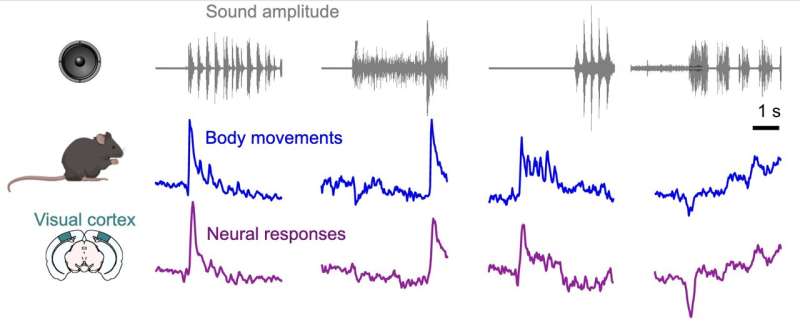Study sheds new light on the origins of sound-evoked activity in the mouse visual cortex

Recent studies have found that brain regions previously thought to only process a specific type of sensory stimuli, such as the visual cortex, can also be affected by other sensory stimuli. This might suggest that these brain regions are in fact multi-sensory, meaning that they can process different sensory stimuli.
Researchers at University College London have recently carried out a study aimed at exploring this hypothesis further, specifically looking at the sound-evoked activity in the visual cortex or V1 area of the mouse brain. Their findings, published in Nature Neuroscience, pin-point the possible origin of the V1 activity evoked by auditory stimuli.
“Increasing evidence shows that visual cortex is being activated by sounds and is thus also ‘auditory’,” Célian Bimbard, one of the researchers who carried out the study, told Medical Xpress. “The field is trying to understand why these signals are here, and where they come from. It is believed that they are inherited from the auditory cortex, which sends projections to the visual cortex. In our study, we challenged this consensus: we tested the hypothesis that these signals actually come from sound-induced changes in the animal’s internal state and behavior.”
Past neuroscience research consistently showed that sounds can sometimes trigger body movements. In recent years, some studies found that these involuntary body movements can elicit widespread activity across the brain.
As part of their study, Bimbard and his colleagues tested the hypothesis that “auditory” responses in visual cortex actually had a behavioral origin. Their prediction was that these responses would be similar across neurons and brain regions, be independent from auditory cortex inputs and be easy to connect to the behavior of the mice they were experimenting on.
“To test this hypothesis, we played sounds to passively-listening mice, while simultaneously monitoring their body movements and recording their brain activity with high-density Neuropixels probes,” Bimbard explained. “We saw that the responses of visual cortex neurons were all very similar to each other, and even looked like the ones from another brain region, the hippocampal formation, which receives very little auditory input.”
Subsequently the researchers also performed transectomies on the mice to cut out fibers going from their auditory to visual cortex. Interestingly, they found that the sound-evoked responses in the mice visual cortex persisted even after its link to the auditory cortex had been surgically severed.
Ultimately, Bimbard and his colleagues built a series of models that predicted the source of the sound-evoked responses in the visual cortex (i.e., whether it was derived directly from sound, from the behavior/movements of the mice, or by a combination of both). They found that the behavior of the mice alone fully explained all of these responses.
“Our study focused on the auditory responses in visual cortex, but it may apply to many other contexts,” Bimbard said. “Building on previous studies, our results imply that to understand what the neurons in the brain are doing, we need to take a step back and always look at what the whole brain and body around them may be doing. This avenue of research opens both methodological avenues (i.e., behavior should be monitored with care) and conceptual questions (i.e., are these embodied representations important for the brain and behavior? Do they support any computation for perception, or cognition in general?).”
Overall, the recent study by this team of researchers suggest that the visual cortex does not react to auditory stimuli per se, but rather to involuntary behavior and movements elicited by these stimuli. In other words, the visual cortex does not seem to be processing auditory stimuli. Instead, it appears to be responding to low-dimensional signals associated with an animal’s internal state and behavior.
“One next step in our research will be to understand where these behaviorally-related signals come from, and how they interact with the local brain activity,” Bimbard added.
More information:
Célian Bimbard et al, Behavioral origin of sound-evoked activity in mouse visual cortex, Nature Neuroscience (2023). DOI: 10.1038/s41593-022-01227-x.
Giuliano Iurilli et al, Sound-Driven Synaptic Inhibition in Primary Visual Cortex, Neuron (2012). DOI: 10.1016/j.neuron.2011.12.026.
Carsen Stringer et al, Spontaneous behaviors drive multidimensional, brainwide activity, Science (2019). DOI: 10.1126/science.aav7893.
Simon Musall et al, Single-trial neural dynamics are dominated by richly varied movements, Nature Neuroscience (2019). DOI: 10.1038/s41593-019-0502-4.
Journal information:
Nature Neuroscience
,
Neuron
,
Science
Source: Read Full Article



